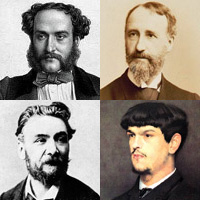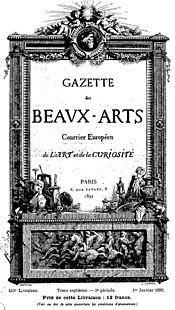Paul Dukas facts for kids
Paul Abraham Dukas (born October 1, 1865 – died May 17, 1935) was a French composer, music critic, and teacher. He was a very careful and private person. He was also very critical of his own work, often giving up on or destroying many of his musical pieces.
His most famous work is the orchestral piece The Sorcerer's Apprentice. This piece is so well-known that it has made his other works less famous. Some of his other important pieces include the opera Ariane et Barbe-bleue, his Symphony in C, and his Piano Sonata in E-flat minor. He also wrote Variations, Interlude and Finale on a Theme by Rameau for piano and a ballet called La Péri.
During his time, French musicians were often split into two groups: those who liked traditional music and those who preferred new, modern styles. Dukas didn't fully join either group, but both sides respected him. His music was influenced by famous composers like Beethoven, Berlioz, Franck, d'Indy, and Debussy.
Besides composing, Dukas also wrote about music. He regularly reviewed music for several French magazines. Later in his life, he became a professor of composition at the Conservatoire de Paris and the École Normale de Musique. Many famous musicians studied with him, including Maurice Duruflé, Olivier Messiaen, Walter Piston, and Joaquín Rodrigo.
Contents
Life and Music Career
Early Life and Studies

Paul Dukas was born in Paris. He was the second of three children in a Jewish family. His father, Jules Dukas, was a banker. His mother, Eugénie, was a talented piano player. When Paul was five, his mother passed away.
Dukas started piano lessons but didn't show any special musical talent until he was 14. That's when he began composing while recovering from an illness. At 16, in 1881, he joined the Conservatoire de Paris. There, he studied piano with Georges Mathias, harmony with Théodore Dubois, and composition with Ernest Guiraud. One of his classmates was Claude Debussy, and they became close friends. Two of Dukas's early orchestral pieces, Goetz de Berlichingen (1883) and Le Roi Lear (1883), still exist from this time. The music for Le Roi Lear was found again in the 1990s and was performed for the first time in 1995.
Dukas won several awards. In 1888, he earned second place in the Conservatoire's top award, the Prix de Rome, for his cantata Velléda. He was disappointed not to win first place, so he left the Conservatoire in 1889. After serving in the military, he started working as both a composer and a music critic.
Music in the 1890s
Dukas began his career as a music critic in 1892. His first review was about Wagner's opera Der Ring des Nibelungen in London. This review was published in La Revue Hebdomadaire. He later wrote for other publications like Minerva and Gazette des Beaux-Arts.
His first public performance as a composer in Paris was his overture Polyeucte. He wrote it in 1891, and it was first performed in January 1892. This piece, like many French works of that time, showed the influence of Wagner.
Even though Dukas wrote a lot of music, he was a perfectionist. He destroyed many of his pieces because he wasn't happy with them. Only a few of his compositions remain today. After Polyeucte, he started writing an opera in 1892. He wrote the story himself, called Horn et Riemenhild, but he only finished one act. He realized the story was better than the music.
His Symphony in C major was composed between 1895 and 1896, when Dukas was in his early 30s. It was first performed in January 1896. This symphony is considered a great achievement of its time. Like Franck's only symphony, Dukas's symphony has three movements instead of the usual four. At its first performance, the symphony received mixed reactions. Some people in the audience and even some musicians in the orchestra didn't like it. However, it was better received when it was performed again in 1902.
After the symphony, Dukas wrote his most famous orchestral work, L'apprenti sorcier (The Sorcerer's Apprentice) in 1897. This short piece, lasting about 10 to 12 minutes, is based on Goethe's poem "Der Zauberlehrling". During Dukas's lifetime, the piece became so famous that it overshadowed all his other works and even Goethe's original poem. Dukas sometimes found its popularity annoying. The piece became even more famous when it was featured in Disney's movie Fantasia.
Works of the 20th Century

In the ten years after The Sorcerer's Apprentice, Dukas finished two challenging piano pieces: the Piano Sonata (1901) and Variations, Interlude and Finale on a Theme by Rameau (1902). Critics have noted that these piano works show the influence of Beethoven and César Franck. Both pieces were first performed by Édouard Risler, a famous pianist. The Sonata is a large and complex piece that isn't played very often, but pianists like Marc-André Hamelin have performed it. The Rameau Variations are seen as more developed and strong.
In 1899, Dukas started another opera. His second attempt, L'arbre de science, was not finished. But in the same year, he began working on his only completed opera, Ariane et Barbe-bleue (Ariadne and Bluebeard). The story for this opera was written by Maurice Maeterlinck. Maeterlinck had originally wanted Grieg to set it to music, but in 1899, he offered it to Dukas. Dukas worked on it for seven years, and it was first performed in 1907.
This opera is often compared to Debussy's Pelléas et Mélisande, which was performed while Dukas was writing Ariane et Barbe-bleue. Both operas use stories by Maeterlinck, and they even have some similar musical ideas. Although Ariane et Barbe-bleue received much praise, its success was overshadowed by the Paris premiere of Richard Strauss's opera Salome around the same time. Despite this, Dukas's opera was performed in other cities like Vienna, Frankfurt, Milan, and New York. It didn't stay in regular performances, but interest in it grew again in the 1990s and 2000s.
Dukas's last major work was the beautiful ballet La Péri (1912). The composer called it a "danced poem." It tells the story of a young Persian prince who searches for the lotus flower of immortality and meets its guardian, the Péri (a fairy). The ballet starts very quietly, so Dukas added a short "Fanfare" to be played before the main piece. This gave the audience time to settle down. La Péri was written for the dancer Natalia Trouhanova, who performed in its first show in 1912.
In 1916, Dukas married Suzanne Pereyra. They had one child, a daughter named Adrienne-Thérèse, born in 1919.
Later Years and Teaching

In his later years, Dukas became well-known as a composition teacher. When Charles-Marie Widor retired from the Paris Conservatoire in 1927, Dukas took his place as professor of composition. He also taught at the École Normale de Musique in Paris. Many of his students became famous composers, including Jehan Alain, Olivier Messiaen, Walter Piston, and Joaquín Rodrigo.
As a teacher, he was traditional but always encouraged his students' talent. He once told a student, "It's clear you truly love music. Always remember that it should be written from the heart, not just with the head." He believed his teaching method was "to help young musicians express themselves in their own way." His deep knowledge of music history and his work editing pieces by composers like Rameau and Beethoven made him a respected teacher.
After La Péri, Dukas didn't finish any new large-scale compositions. However, he did create a tribute to his friend Debussy in 1920, a piano piece called La plainte, au loin, du faune.... In 1924, he published Amours, a song for voice and piano. Before he passed away, he was working on a piece inspired by Shakespeare's play The Tempest.
In his last year, Dukas was elected to the Académie des Beaux-Arts, a prestigious French arts academy. Even though he didn't pick a side in the musical arguments of his time, he was friends with and respected by musicians from both traditional and modern groups. Many famous composers, like Vincent d'Indy, Debussy, Saint-Saëns, and Fauré, admired him and his work.
Dukas passed away in Paris in 1935, at the age of 69. His ashes are kept at the Père Lachaise Cemetery in Paris.
List of Works
Published by the Composer
- Polyeucte, an overture for orchestra (1891)
- Symphony in C (1895–96)
- The Sorcerer's Apprentice, for orchestra (1897)
- Piano Sonata in E-flat minor (1899–1900)
- Variations, Interlude and Finale on a Theme by Rameau, for piano (c.1899–1902)
- Ariane et Barbe-bleue, an opera (1899–1907)
- Villanelle, for horn and piano (1906)
- Prélude élégiaque sur le nom de Haydn, for piano (1909)
- Vocalise-étude (alla gitana), for voice and piano (1909)
- La Péri, a ballet (danced poem) (1911; later added with Fanfare pour précéder La Péri (1912))
- La plainte, au loin, du faune..., for piano (1920)
- Amours, a sonnet for voice and piano (1924)
- Allegro, for piano (1925)
- Modéré, for piano (?) (1933; published after his death in 1936)
See also
 In Spanish: Paul Dukas para niños
In Spanish: Paul Dukas para niños



